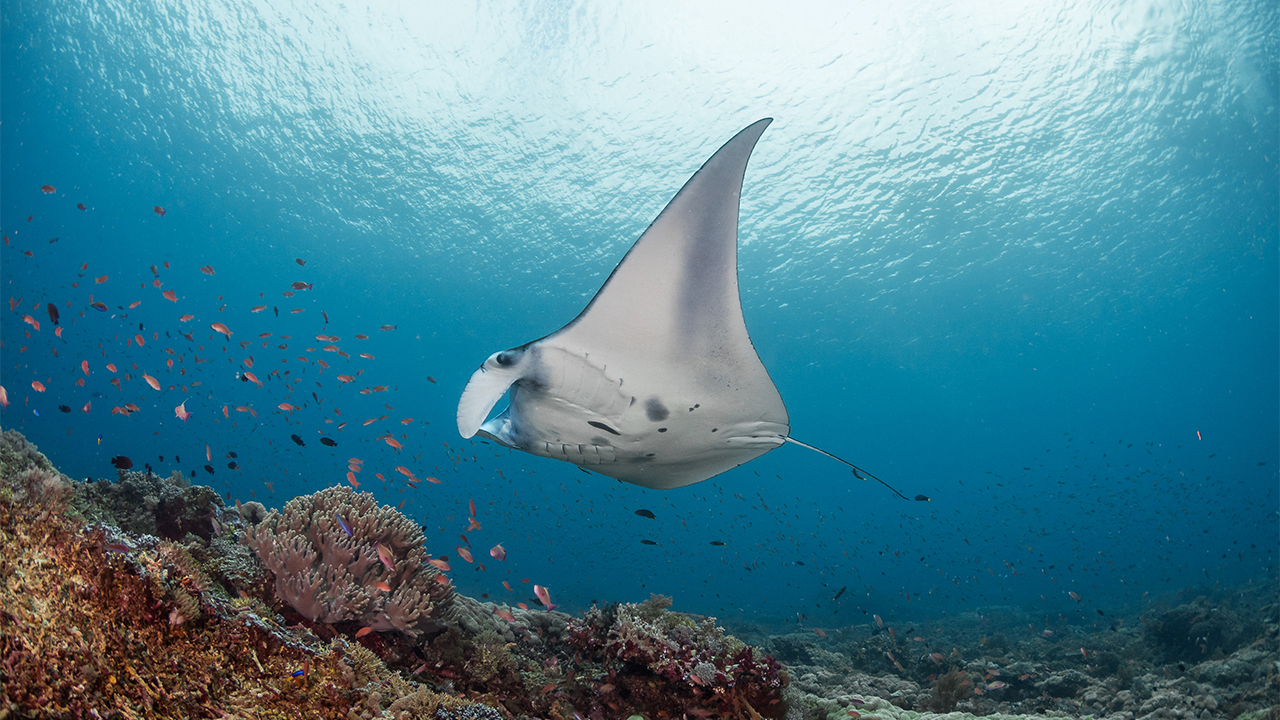
Tangled up too often in fishing nets, manta rays have been plunging toward extinction as fishing pressure and other stressors take a toll on their populations. But the species has found a safe haven in Komodo National Park, a swath of water around Indonesia’s Lesser Sunda Islands.
A new study identified an aggregation of 1,085 reef manta rays (Mobula alfredi) in the waters of Komodo National Park (KNP), a UNESCO World Heritage Site that spans more than 1,800 square kilometers (700 square miles) of islands and ocean. Attracted by the plankton-rich waters of the park, manta rays gather here to feed, breed, and clean themselves.
Across the world, manta rays are targeted for their gill plates, which are used in Chinese medicine, or accidentally caught as bycatch.
Indonesia used to have one of the most productive manta ray fisheries, but in 2014, the country pledged to protect both reef manta rays and giant manta rays (Mobula birostris) by making it illegal to catch them or trade any of their body parts. Despite this move, experts say illegal fishing still takes place in and around Indonesia, and that fishers continue to catch manta rays as bycatch.
The study found that 56 of the surveyed manta rays had fishing gear-related injuries.
“Some of these contacts are undoubtedly accidental, but it highlights that fishing activity is still a problem for manta rays within their range,” Germanov said.
Tourism activities, when conducted irresponsibly, can also be a threat. Manta rays can get struck by boat hulls and propellers. They’re also sensitive to noise and other forms of disturbance.
“Within KNP, the rise in tourism pressure before the pandemic can disturb manta rays’ natural behavior or displace rays to less preferred sites, which might have knock-on effects on health and reproduction,” Germanov said. “Establishing and enforcing clear guidelines for sustainable tourism could be beneficial here.”
Like a lot of other marine species, manta rays are under pressure from the changing dynamics of the ocean brought on by rising temperatures, ocean acidification, and different kinds of marine pollution, such as plastic, which can decrease the quality of their food, according to Germanov.
What makes manta rays particularly vulnerable to extinction is their slow rate of reproduction. They become sexually mature at about 10 years old, and they tend to have one offspring every two years.
The study relied on photo identification data collected by both researchers and citizen scientists.
“A large amount of the success of this study is due to the local diving operators and staff that helped collect the data used in manta ray monitoring,” Germanov said. “This study is an excellent example of how partnerships between management, stakeholders, the public, and researchers can better understand threatened species to assist in their conservation.”
Reef manta rays are classified as a vulnerable species on the IUCN Red List, and global populations continue to plummet, says Joanna Harris, a researcher at the U.K.-based Manta Trust, who was not involved in this study.
“Populations like the one described in this paper … are going to be the ones that are strongholds for the species,” Harris told Mongabay. “It’s a very likely reality that some of the other populations will suffer from local extinction, so a paper like this is really important to highlight pressures from illegal fishing, which is something that is always difficult to deal with and is prevalent in many regions.”
Other places known to have large aggregations of manta rays include the Bird’s Head seascape in Indonesia’s West Papua province, and the Maldives.
“Finding large aggregations in KNP gives us hope that by addressing all remaining threats within KNP and adding additional mitigation efforts in surrounding areas, we might, in time, see regional manta ray population reverse their declining trends,” Germanov said.